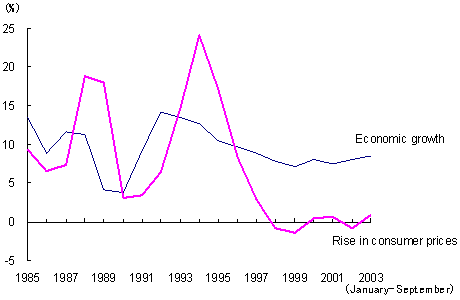Although China's economy temporarily slowed in the second quarter due to the effects of severe acute respiratory syndrome, growth rebounded to 9.1% in the third quarter, and a high growth of 8.5% was registered between the first and third quarters (diagram). The current upturn has been led by investment. The pace of investment increase began accelerating in the latter half of last year, and despite the outbreak of SARS, fixed capital investment for the January-September period has grown 30.5% on a year-on-year basis. Against such a backdrop, the consumer price index, which fell 0.8% last year, registered a year-on-year rise of 1.1% in September, and the rising trend has become more and more apparent. However, the opinions of policymakers and many economists are divided on whether such a situation is economic overheating or just a presage of it.
First, the People's Bank of China, China's central bank, warned of the dangers that lurk behind the increase in bank lending and surging investment in certain areas such as real estate and the automobile industry in its Monetary Policy report of Q2 2003 (Aug. 5, 2003). The money supply in June surged 20.8% year-on-year to 20.5 trillion yuan, the highest growth since 1998. In response, the report calls to attention the fact that, "[S]ince China's credit system is still underdeveloped and the mechanism of internal control at banks still needs improvement, a protracted high growth of credit would likely foster duplicated construction and stockpiling of inventory, and subsequently lead to a rise of nonperforming loans and financial risks." Based on such awareness, the People's Bank of China has implemented a series of preventive measures, such as actively conducting open market operations to keep the rapidly rising money supply in check, issuing its "Notice on Further Strengthening Management of Real Estate Credit" and raising the reserve ratio for commercial banks to 7% from 6% as of September 21. China saw a nationwide investment boom that led to double-digit inflation and economic confusion for three straight years between 1993 and 1995, following Deng Xiaoping's famous speech during his Southern China Tour in 1992. It is certain that the swift action on the part of monetary authorities this time is a result of reflection on this experience.
Many economists, however, have voiced their objections to such a cautious stance on the part of the authorities. Those who reject the idea that the economy is overheating cite as basis for such reasons the following: 1) while the prices of some raw materials such as crude oil are rising, consumer prices are generally stable; 2) prices can be stabilized by increasing supply through imports, backed by China's abundant foreign exchange reserves; 3) growth has yet to reach its potential, judging from high unemployment and the low capacity utilization rate; 4) demand for investment is being generated through industrialization and urbanization, and investment in autos, steel and housing is supported by real demand; 5) while real estate prices are rising, this is limited to certain areas, and is not seen on a nationwide scale. (Zhu Baoliang, Qi Jingmei, "The Chinese Economy is not Overheating Yet," China Economic Times, Sept. 20, 2003.)
These conflicting views on the economy reflect different evaluations of the level of China's potential growth rate and the maturity of its market economy. Those who express caution, such as policymakers, believe China's current growth has exceeded its potential given the many structural problems it faces. Also, because the market economy in China remains at an immature stage, government influence remains strong, and not only public investment but also investment by state-owned enterprises lacks rationality. Coupled with overly optimistic demand forecasts, a decline in investment efficiency is feared. In contrast, those who remain optimistic predict that progress in structural reforms is boosting China's potential growth rate, so it is unlikely that demand will exceed supply even if investment increases. Furthermore, reflecting the permeation of market mechanisms, companies have begun to make investments based on self-responsibility, making it unlikely that an overheating such as that seen before will occur. However, it is clear that China's market economy is still at an early stage of development, and when we consider the fact that bubbles repeatedly expand and burst, even in such mature market economies as the United States and Japan, people should not be overconfident. I would therefore like to praise the cautious stance of the authorities, which aim at stable and sustainable growth, rather than the optimistic opinions of the economists, which are full of wishful thinking.



